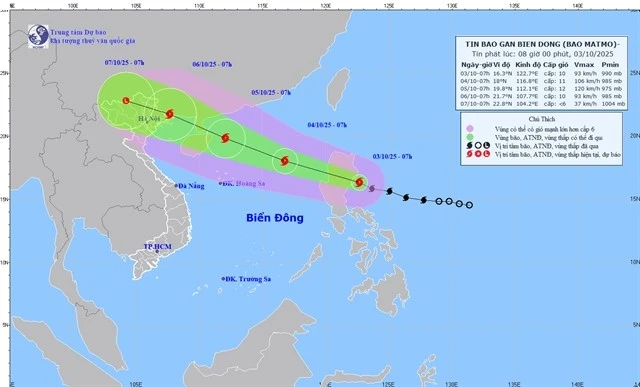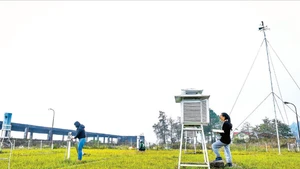At 1am on October 3, the storm's centre was located east of Luzon Island in the Philippines, with maximum sustained winds of 75–88km/h and gusts up to 103-117km/h.
It was moving west-northwest at about 25km/h.
Forecasters say the storm will continue strengthening after entering the East Sea/ South China Sea on October 4. Winds could increase to 89–102km/h with gusts reaching 118-133km/h.
By October 5, Matmo is projected to intensify further with gusts near 167-183km/h as it tracks toward the northwestern part of the sea, about 340km east-southeast of China’s Leizhou Peninsula.
By next week's Monday, the storm is expected to be over the northern Gulf of Tonkin with sustained winds of around 103–117km/h and stronger gusts, before gradually weakening as it continues west-northwest at 15–20km/h.
The storm will generate extremely rough seas, with waves four to six meters high. From Friday afternoon, the northeastern waters of the East Sea/ South China Sea are forecast to see winds strengthening to 40–60km/h and later increasing to 60–90km/h.
Between October 4 and 5, the northern parts of the sea could be lashed by winds exceeding 120km/h.
Authorities have warned all vessels operating in the area to take precautions against violent winds, thunderstorms, waterspouts and towering waves.
On land, the storm’s circulation is forecast to deliver widespread rainfall between October 5 and 7 across northern and north-central provinces and cities.
Totals are expected to reach 100–200ml, with coastal areas from Thanh Hoa to Quang Ninh potentially receiving over 250ml.
The risk of flash floods and landslides in mountainous regions is high, as is urban flooding in low-lying areas.
The fresh threat comes just days after Typhoon Bualoi battered northern Viet Nam, leaving 65 people dead or missing, 153 injured, and causing preliminary economic losses of more than 12.8 trillion VND (485 million USD).
Local authorities are still working to repair homes and carry out clean-up when the arrival of Matmo has added new pressure to already stretched disaster-response efforts.
















